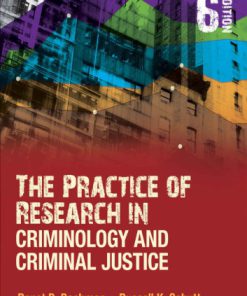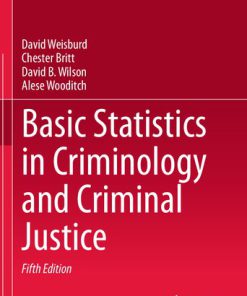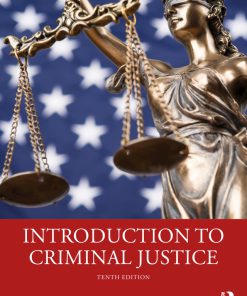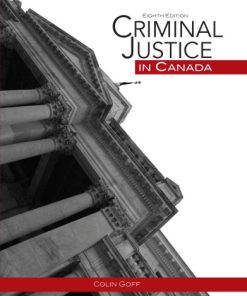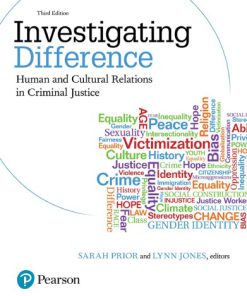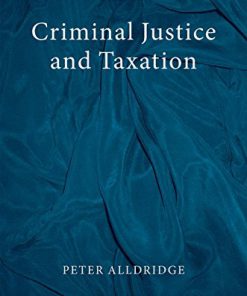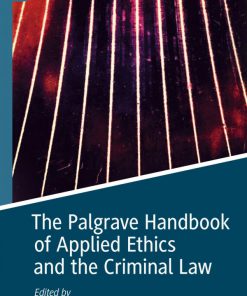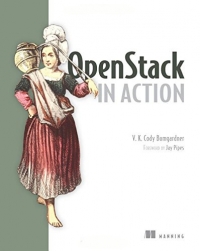Criminal Justice in Action 10th Edition by Larry Gaines, Roger LeRoy Miller 8214341026 9798214341026
$50.00 Original price was: $50.00.$25.00Current price is: $25.00.
Criminal Justice in Action 10th Edition by Larry K. Gaines, Roger LeRoy Miller – Ebook PDF Instant Download/DeliveryISBN: 8214341026, 9798214341026
Full download Criminal Justice in Action 10th Edition after payment.
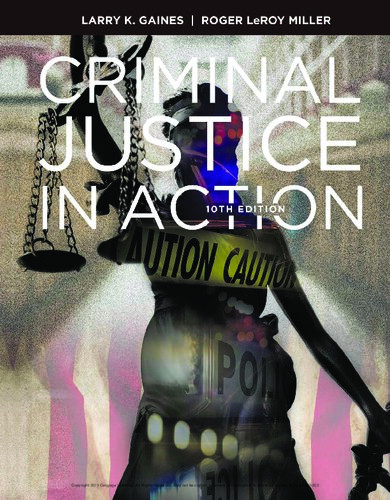
Product details:
ISBN-10 : 8214341026
ISBN-13 : 9798214341026
Author: Larry K. Gaines, Roger LeRoy Miller
The tenth edition of CRIMINAL JUSTICE IN ACTION places you in the center of the action and helps you excel in your criminal justice course. You’ll explore vivid real-life applications that clarify key concepts, and have opportunities to provide your own opinions on the most pressing and controversial issues in the field. Chapter material makes sense, thanks to straight-from-the-headlines vignettes that show the relevance of upcoming discussions. Choosing what’s important to remember is a snap with each chapter’s numbered objectives, which are reinforced throughout the chapter. And to gear you up for a rewarding career, each chapter includes advice from a criminal justice professional and a practical guide to researching potential CJ careers online.
Important Notice: Media content referenced within the product description or the product text may not be available in the ebook version.
Criminal Justice in Action 10th Table of contents:
Part 1. The Criminal Justice System
A Study Skills Module
Skill Prep. A Study Skills Module
What’s Inside
Life Prep
Time Prep
Study Prep
Test Prep
Read Prep
Write Prep
1. Criminal Justice Today
What Is Crime?
Determining Criminal Behavior
An Integrated Definition of Crime
Types of Crime
The Purpose of the Criminal Justice System
Maintaining Justice
Protecting Society
The Structure of the Criminal Justice System
The Importance of Federalism
The Criminal Justice Process
Discretion and Ethics
Informal Decision Making
Ethics and Justice
Criminal Justice Today
Crime and Law Enforcement: The Bottom Line
Gun Control Policy
The Changing Landscape of American Policing
Homeland Security and Domestic Terrorism
Prison Population Trends
Summary
Questions for Critical Analysis
Key Terms
Chapter One Appendix. How to Read Case Citations and Find Court Decisions
2. Causes of Crime
The Role of Theory
Correlation and Cause
Criminological Theories
The Brain and the Body
Crime and Free Will: Choice Theories of Crime
“Born Criminal”: Biological and Psychological Theories of Crime
Bad Neighborhoods and Other Economic Disadvantages
Sociological Theories of Crime
Social Conflict Theories
Life Lessons and Criminal Behavior
Family, Friends, and the Media: Social Processes of Crime
Looking Back to Childhood: Life Course Theories of Crime
The Link between Drugs and Crime
The Criminology of Drug Use
Drug Addiction and Dependency
Crime and Health: The Landscape of Drug Abuse
Marijuana Law Trends
Criminology from Theory to Practice
Criminology and the Chronic Offender
Risk Assessment in Action
Summary
Questions for Critical Analysis
Key Terms
3. The Crime Picture: Offenders and Victims
Classification of Crimes
Civil Law and Criminal Law
Felonies and Misdemeanors
Mala in Se and Mala Prohibita
Measuring Crime in the United States
The Uniform Crime Reports
The UCR: A Flawed Method?
The National Incident-Based Reporting System
Victim Surveys
Self-Reported Surveys
Victims of Crime
Legal Rights of Crime Victims
Victim Services
The Risks of Victimization
Crime Trends in the United States
Looking Good: Crime in the 1990s and 2000s
Crime, Race, and Poverty
Women and Crime
Mental Illness and Crime
Summary
Questions for Critical Analysis
Key Terms
4. Inside Criminal Law
The Development of American Criminal Law
English Common Law
Written Sources of American Criminal Law
The Purposes of Criminal Law
Protect and Punish: The Legal Function of the Law
Maintain and Teach: The Social Function of the Law
The Elements of a Crime
Criminal Act: Actus Reus
Mental State: Mens Rea
Concurrence
Causation
Attendant Circumstances
Harm
Defenses under Criminal Law
Excuse Defenses
Justification Defenses
Procedural Safeguards
The Bill of Rights
Due Process
Summary
Questions for Critical Analysis
Key Terms
Part 2. The Police and Law Enforcement
5. Law Enforcement Today
The Responsibilities of the Police
Enforcing Laws
Providing Services
Preventing Crime
Preserving the Peace
A Short History of the American Police
The Evolution of American Law Enforcement
Policing Today
Recruitment and Training: Becoming a Police Officer
Basic Requirements
Training
Women and Minorities in Policing Today
Antidiscrimination Law
Working Women: Gender and Law Enforcement
Minority Report: Race and Ethnicity in Law Enforcement
Public and Private Law Enforcement
Municipal Law Enforcement Agencies
Sheriffs and County Law Enforcement
State Police and Highway Patrols
Limited-Purpose Law Enforcement Agencies
Federal Law Enforcement Agencies
Private Security
Summary
Questions for Critical Analysis
Key Terms
6. Problems and Solutions in Modern Policing
The Role of Discretion in Policing
Justification for Police Discretion
Factors of Police Discretion
Police Organization and Field Operations
The Structure of the Police Department
Police on Patrol: The Backbone of the Department
Detective Investigations
Aggressive Investigation Strategies
Clearance Rates and Cold Cases
Forensic Investigations and DNA
Police Strategies: What Works
Calls for Service
Patrol Strategies
Smart Policing
Arrest Strategies
Community Policing and Problem Solving
“Us versus Them”: Issues in Modern Policing
Police Subculture
The Physical Dangers of Police Work
Stress and the Mental Dangers of Police Work
Police Use of Force
Police Misconduct and Ethics
Police Corruption
Police Accountability
Issues of Bias in Policing
Ethics in Law Enforcement
Summary
Questions for Critical Analysis
Key Terms
7. Police and the Constitution: The Rules of Law Enforcement
The Fourth Amendment
Reasonableness
Probable Cause
The Exclusionary Rule
Lawful Searches and Seizures
The Role of Privacy in Searches
Search and Seizure Warrants
Searches and Seizures without a Warrant
Searches of Automobiles
The Plain View Doctrine
Electronic Surveillance
Cell Phones and the Fourth Amendment
Stops and Frisks
The Elusive Definition of Reasonable Suspicion
A Stop
A Frisk
Race and Reasonable Suspicion
Arrests
Elements of an Arrest
Arrests with a Warrant
Arrests without a Warrant
The Interrogation Process and Miranda
The Legal Basis for Miranda
When a Miranda Warning Is Required
When a Miranda Warning Is Not Required
The Weakening of Miranda
False Confessions
The Identification Process
Essential Procedures
Nontestimonial Evidence
Summary
Questions for Critical Analysis
Key Terms
Part 3. Criminal Courts
8. Courts and the Quest for Justice
Functions of the Courts
Due Process and Crime Control in the Courts
The Rehabilitation Function
The Bureaucratic Function
The Basic Principles of the American Judicial System
Jurisdiction
Trial and Appellate Courts
The Dual Court System
State Court Systems
Courts of Limited Jurisdiction
Trial Courts of General Jurisdiction
State Courts of Appeals
The Federal Court System
U.S. District Courts
U.S. Courts of Appeals
The United States Supreme Court
Judges in the Court System
The Roles and Responsibilities of Trial Judges
Appointment of Judges
Election of Judges
Judicial Decision Making
Diversity on the Bench
The Courtroom Work Group
Members of the Courtroom Work Group
Formation of the Courtroom Work Group
The Judge in the Courtroom Work Group
The Adversary System
Summary
Questions for Critical Analysis
Key Terms
9. Pretrial Procedures: The Adversary System in Action
The Prosecution
Prosecutorial Duties
The Office of the Prosecutor
The Prosecutor as Elected Official
The Prosecutor as Crime Fighter
The Defense Attorney
The Responsibilities of the Defense Attorney
Defending the Guilty
The Public Defender
The Attorney-Client Relationship
Attorney-Client Privilege
Pretrial Detention
The Initial Appearance
Bail and Pretrial Release
Alternatives to Bail
Establishing Probable Cause
The Preliminary Hearing
The Grand Jury
The Prosecutorial Screening Process
Case Attrition
Prosecutorial Charging and the Defense Attorney
Pleading Guilty
Plea Bargaining in the Criminal Justice System
Motivations for Plea Bargaining
Plea Bargaining and the Adversary System
Going to Trial
Summary
Questions for Critical Analysis
Key Terms
10. The Criminal Trial
Special Features of Criminal Trials
A “Speedy” Trial
The Role of the Jury
The Privilege against Self-Incrimination
The Presumption of Innocence
A Strict Standard of Proof
Jury Selection
Initial Steps: The Master Jury List and Venire
Voir Dire
Race and Gender Issues in Jury Selection
Alternate Jurors
The Trial
Opening Statements
The Role of Evidence
The Prosecution’s Case
Cross-Examination
Motion for a Directed Verdict
The Defendant’s Case
Rebuttal and Surrebuttal
Closing Arguments
The Final Steps of the Trial and Postconviction Procedures
Jury Instructions
Jury Deliberation
The Verdict
Appeals
Wrongful Convictions
Summary
Questions for Critical Analysis
Key Terms
11. Punishment and Sentencing
The Purpose of Sentencing
Retribution
Deterrence
Incapacitation
Rehabilitation
Restorative Justice
The Structure of Sentencing
Legislative Sentencing Authority
Administrative Sentencing Authority
Judicial Sentencing Authority
The Sentencing Process
Factors of Sentencing
Inconsistencies in Sentencing
Sentencing Disparity
Sentencing Discrimination
Sentencing Reform
Sentencing Guidelines
Mandatory Sentencing Guidelines
Victim Impact Evidence
Capital Punishment
Methods of Execution
The Death Penalty and the Supreme Court
Death Penalty Sentencing
Debating the Sentence of Death
The Future of the Death Penalty
Summary
Questions for Critical Analysis
Key Terms
Part 4. Corrections
12. Probation, Parole, and Intermediate Sanctions
The Justifications for Community Corrections
Reintegration
Diversion
The “Low-Cost Alternative”
Probation: Doing Time in the Community
Sentencing and Probation
Conditions of Probation
The Supervisory Role of the Probation Officer
Revocation of Probation
Does Probation Work?
The Parole Picture
Comparing Probation and Parole
Discretionary Release
Parole Guidelines
Victims’ Rights and Parole
Intermediate Sanctions
Judicially Administered Sanctions
Day Reporting Centers
Intensive Supervision Probation
Shock Incarceration
Home Confinement and Electronic Monitoring
Widening the Net
The Paradox of Community Corrections
Summary
Questions for Critical Analysis
Key Terms
13. Prisons and Jails
A Short History of American Prisons
English Roots
Walnut Street Prison: The First Penitentiary
The Great Penitentiary Rivalry: Pennsylvania versus New York
The Reformers and the Progressives
The Reassertion of Punishment
The Role of Prisons in Modern Society
Prison Organization and Management
Prison Administration
Types of Prisons
Inmate Population Trends
Factors in Prison Population Growth
Decarceration
The Consequences of America’s High Rates of Incarceration
Private Prisons
Why Privatize?
The Argument against Private Prisons
The Future of Private Prisons
Jails
The Jail Population
Jail Administration
New-Generation Jails
Summary
Questions for Critical Analysis
Key Terms
14. The Prison Experience and Prisoner Reentry
Prison Culture
Adapting to Prison Society
Who Is in Prison?
Rehabilitation and Prison Programs
Prison Violence
Violence in Prison Culture
Riots
Prison Rape
Issues of Race and Ethnicity
Prison Gangs and Security Threat Groups (STGs)
Correctional Officers and Discipline
Prison Employment
Discipline
Female Correctional Officers
Protecting Prisoners’ Rights
Inside a Women’s Prison
Characteristics of Female Inmates
The Motherhood Problem
The Culture of Women’s Prisons
Return to Society
Types of Prison Release
The Challenges of Reentry
The Special Case of Sex Offenders
Summary
Questions for Critical Analysis
Key Terms
Part 5. Special Issues
15. The Juvenile Justice System
The Evolution of American Juvenile Justice
The Child-Saving Movement
The Illinois Juvenile Court
Status Offending
Juvenile Delinquency
Constitutional Protections and the Juvenile Court
Determining Delinquency Today
The Age Question
The Culpability Question
Trends in Juvenile Delinquency
Delinquency by the Numbers
School Violence
Bullying
Factors in Juvenile Delinquency
The Age-Crime Relationship
Substance Abuse
Child Abuse and Neglect
Gangs
First Contact: The Police and Pretrial Procedures
Police Discretion and Juvenile Crime
Intake
Pretrial Diversion
Transfer to Adult Court
Detention
Trying and Punishing Juveniles
Adjudication
Disposition
Juvenile Corrections
Summary
Questions for Critical Analysis
Key Terms
16. Today’s Challenges: Cyber Crime, Security vs. Liberty, and White-Collar Crime
Cyber Crime
Crime and the Internet
Cyber Trespass
Cyber Deception and Theft
Cyber Violence
Fighting Cyber Crime
Security vs. Liberty
National Security and Privacy
Mass Surveillance
National Security and Speech
White-Collar Crime
What Is White-Collar Crime?
Regulating and Policing White-Collar Crime
Summary
Questions for Critical Analysis
Key Terms
People also search for Criminal Justice in Action 10th:
criminal justice in action 11th edition
borrow criminal justice in action
criminal justice in action the core 9th edition
criminal justice in action 11th edition pdf
criminal justice in action pdf
Tags: Criminal Justice, Action, Larry Gaines, Roger LeRoy Miller
You may also like…
Politics & Philosophy - Social Sciences
Jurisprudence & Law - Criminal Law & Procedure
Introduction to Criminal Justice 10th Edition Bradley D. Edwards
Jurisprudence & Law
Changing contours of criminal justice 1st Edition Mary Bosworth
Jurisprudence & Law - Criminal Law & Procedure
Criminal Justice in Canada Eighth Edition Colin Harford Goff
Jurisprudence & Law - Legal Theory & Philosophy
Investigating Difference Human and Cultural Relations in Criminal Justice Sarah Prior
Jurisprudence & Law - Criminal Law & Procedure
Criminal justice and taxation 1st Edition by Peter Alldridge 0191073962 9780191073960
Politics & Philosophy - Anthropology
The Palgrave Handbook of Applied Ethics and the Criminal Law Larry Alexander
Computers - Organization and Data Processing Computers - Programming
OpenStack in Action 1st Edition Bumgardner 1638352186 9781638352181




